Critical Reflection on Medication Error Assignment 2022
VerifiedAdded on 2022/10/11
|7
|1700
|18
Assignment
AI Summary
Contribute Materials
Your contribution can guide someone’s learning journey. Share your
documents today.
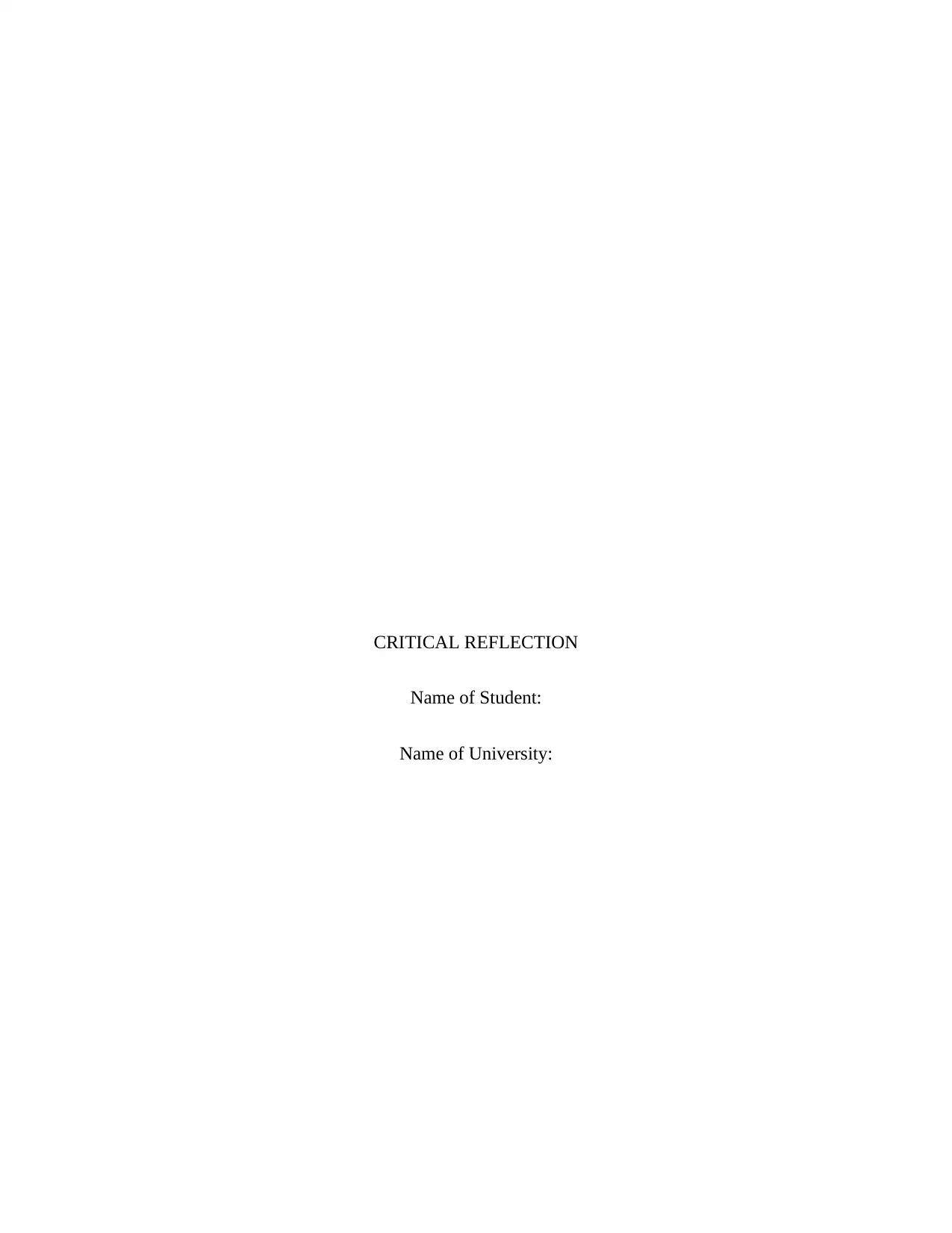
CRITICAL REFLECTION
Name of Student:
Name of University:
Name of Student:
Name of University:
Secure Best Marks with AI Grader
Need help grading? Try our AI Grader for instant feedback on your assignments.
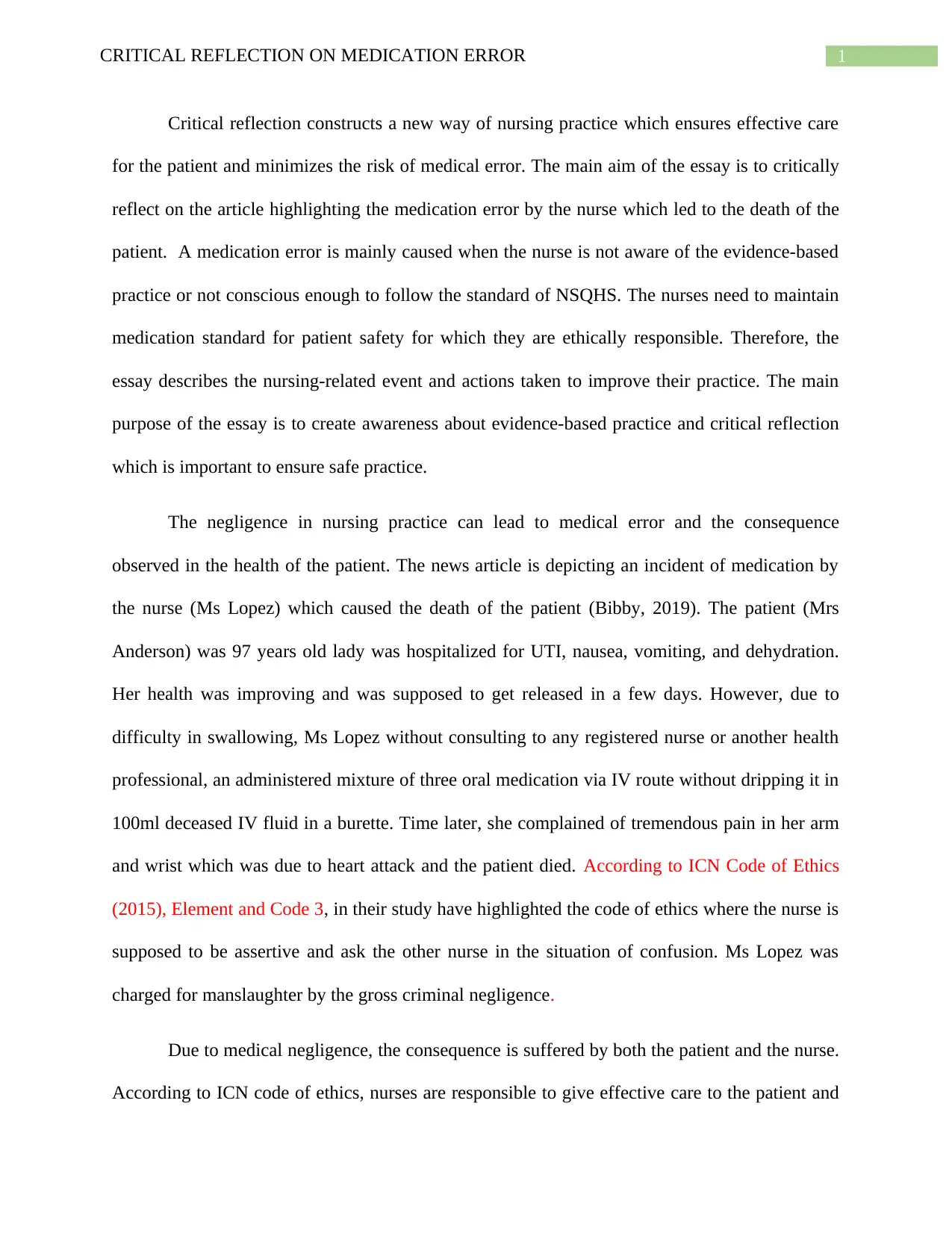
1CRITICAL REFLECTION ON MEDICATION ERROR
Critical reflection constructs a new way of nursing practice which ensures effective care
for the patient and minimizes the risk of medical error. The main aim of the essay is to critically
reflect on the article highlighting the medication error by the nurse which led to the death of the
patient. A medication error is mainly caused when the nurse is not aware of the evidence-based
practice or not conscious enough to follow the standard of NSQHS. The nurses need to maintain
medication standard for patient safety for which they are ethically responsible. Therefore, the
essay describes the nursing-related event and actions taken to improve their practice. The main
purpose of the essay is to create awareness about evidence-based practice and critical reflection
which is important to ensure safe practice.
The negligence in nursing practice can lead to medical error and the consequence
observed in the health of the patient. The news article is depicting an incident of medication by
the nurse (Ms Lopez) which caused the death of the patient (Bibby, 2019). The patient (Mrs
Anderson) was 97 years old lady was hospitalized for UTI, nausea, vomiting, and dehydration.
Her health was improving and was supposed to get released in a few days. However, due to
difficulty in swallowing, Ms Lopez without consulting to any registered nurse or another health
professional, an administered mixture of three oral medication via IV route without dripping it in
100ml deceased IV fluid in a burette. Time later, she complained of tremendous pain in her arm
and wrist which was due to heart attack and the patient died. According to ICN Code of Ethics
(2015), Element and Code 3, in their study have highlighted the code of ethics where the nurse is
supposed to be assertive and ask the other nurse in the situation of confusion. Ms Lopez was
charged for manslaughter by the gross criminal negligence.
Due to medical negligence, the consequence is suffered by both the patient and the nurse.
According to ICN code of ethics, nurses are responsible to give effective care to the patient and
Critical reflection constructs a new way of nursing practice which ensures effective care
for the patient and minimizes the risk of medical error. The main aim of the essay is to critically
reflect on the article highlighting the medication error by the nurse which led to the death of the
patient. A medication error is mainly caused when the nurse is not aware of the evidence-based
practice or not conscious enough to follow the standard of NSQHS. The nurses need to maintain
medication standard for patient safety for which they are ethically responsible. Therefore, the
essay describes the nursing-related event and actions taken to improve their practice. The main
purpose of the essay is to create awareness about evidence-based practice and critical reflection
which is important to ensure safe practice.
The negligence in nursing practice can lead to medical error and the consequence
observed in the health of the patient. The news article is depicting an incident of medication by
the nurse (Ms Lopez) which caused the death of the patient (Bibby, 2019). The patient (Mrs
Anderson) was 97 years old lady was hospitalized for UTI, nausea, vomiting, and dehydration.
Her health was improving and was supposed to get released in a few days. However, due to
difficulty in swallowing, Ms Lopez without consulting to any registered nurse or another health
professional, an administered mixture of three oral medication via IV route without dripping it in
100ml deceased IV fluid in a burette. Time later, she complained of tremendous pain in her arm
and wrist which was due to heart attack and the patient died. According to ICN Code of Ethics
(2015), Element and Code 3, in their study have highlighted the code of ethics where the nurse is
supposed to be assertive and ask the other nurse in the situation of confusion. Ms Lopez was
charged for manslaughter by the gross criminal negligence.
Due to medical negligence, the consequence is suffered by both the patient and the nurse.
According to ICN code of ethics, nurses are responsible to give effective care to the patient and
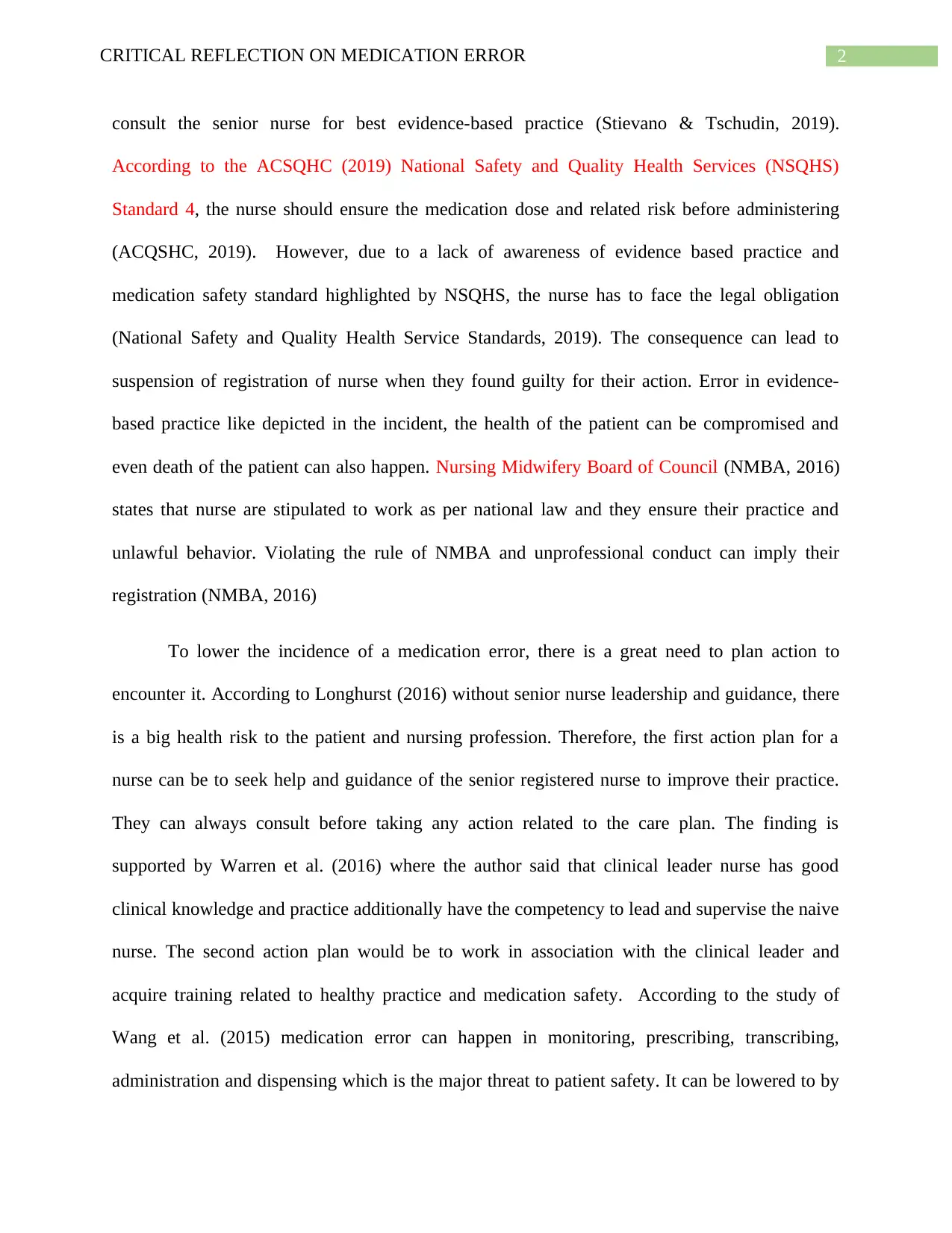
2CRITICAL REFLECTION ON MEDICATION ERROR
consult the senior nurse for best evidence-based practice (Stievano & Tschudin, 2019).
According to the ACSQHC (2019) National Safety and Quality Health Services (NSQHS)
Standard 4, the nurse should ensure the medication dose and related risk before administering
(ACQSHC, 2019). However, due to a lack of awareness of evidence based practice and
medication safety standard highlighted by NSQHS, the nurse has to face the legal obligation
(National Safety and Quality Health Service Standards, 2019). The consequence can lead to
suspension of registration of nurse when they found guilty for their action. Error in evidence-
based practice like depicted in the incident, the health of the patient can be compromised and
even death of the patient can also happen. Nursing Midwifery Board of Council (NMBA, 2016)
states that nurse are stipulated to work as per national law and they ensure their practice and
unlawful behavior. Violating the rule of NMBA and unprofessional conduct can imply their
registration (NMBA, 2016)
To lower the incidence of a medication error, there is a great need to plan action to
encounter it. According to Longhurst (2016) without senior nurse leadership and guidance, there
is a big health risk to the patient and nursing profession. Therefore, the first action plan for a
nurse can be to seek help and guidance of the senior registered nurse to improve their practice.
They can always consult before taking any action related to the care plan. The finding is
supported by Warren et al. (2016) where the author said that clinical leader nurse has good
clinical knowledge and practice additionally have the competency to lead and supervise the naive
nurse. The second action plan would be to work in association with the clinical leader and
acquire training related to healthy practice and medication safety. According to the study of
Wang et al. (2015) medication error can happen in monitoring, prescribing, transcribing,
administration and dispensing which is the major threat to patient safety. It can be lowered to by
consult the senior nurse for best evidence-based practice (Stievano & Tschudin, 2019).
According to the ACSQHC (2019) National Safety and Quality Health Services (NSQHS)
Standard 4, the nurse should ensure the medication dose and related risk before administering
(ACQSHC, 2019). However, due to a lack of awareness of evidence based practice and
medication safety standard highlighted by NSQHS, the nurse has to face the legal obligation
(National Safety and Quality Health Service Standards, 2019). The consequence can lead to
suspension of registration of nurse when they found guilty for their action. Error in evidence-
based practice like depicted in the incident, the health of the patient can be compromised and
even death of the patient can also happen. Nursing Midwifery Board of Council (NMBA, 2016)
states that nurse are stipulated to work as per national law and they ensure their practice and
unlawful behavior. Violating the rule of NMBA and unprofessional conduct can imply their
registration (NMBA, 2016)
To lower the incidence of a medication error, there is a great need to plan action to
encounter it. According to Longhurst (2016) without senior nurse leadership and guidance, there
is a big health risk to the patient and nursing profession. Therefore, the first action plan for a
nurse can be to seek help and guidance of the senior registered nurse to improve their practice.
They can always consult before taking any action related to the care plan. The finding is
supported by Warren et al. (2016) where the author said that clinical leader nurse has good
clinical knowledge and practice additionally have the competency to lead and supervise the naive
nurse. The second action plan would be to work in association with the clinical leader and
acquire training related to healthy practice and medication safety. According to the study of
Wang et al. (2015) medication error can happen in monitoring, prescribing, transcribing,
administration and dispensing which is the major threat to patient safety. It can be lowered to by
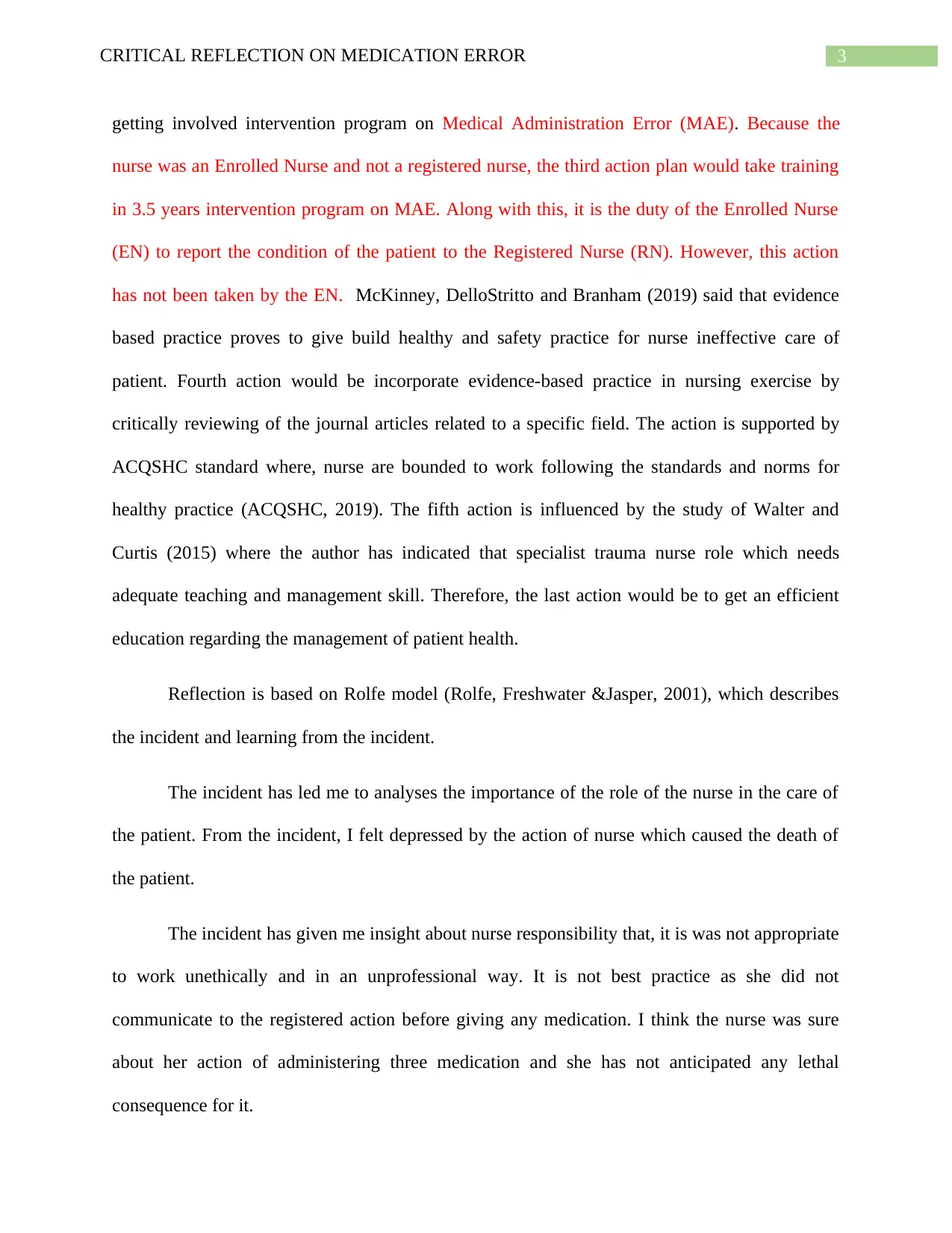
3CRITICAL REFLECTION ON MEDICATION ERROR
getting involved intervention program on Medical Administration Error (MAE). Because the
nurse was an Enrolled Nurse and not a registered nurse, the third action plan would take training
in 3.5 years intervention program on MAE. Along with this, it is the duty of the Enrolled Nurse
(EN) to report the condition of the patient to the Registered Nurse (RN). However, this action
has not been taken by the EN. McKinney, DelloStritto and Branham (2019) said that evidence
based practice proves to give build healthy and safety practice for nurse ineffective care of
patient. Fourth action would be incorporate evidence-based practice in nursing exercise by
critically reviewing of the journal articles related to a specific field. The action is supported by
ACQSHC standard where, nurse are bounded to work following the standards and norms for
healthy practice (ACQSHC, 2019). The fifth action is influenced by the study of Walter and
Curtis (2015) where the author has indicated that specialist trauma nurse role which needs
adequate teaching and management skill. Therefore, the last action would be to get an efficient
education regarding the management of patient health.
Reflection is based on Rolfe model (Rolfe, Freshwater &Jasper, 2001), which describes
the incident and learning from the incident.
The incident has led me to analyses the importance of the role of the nurse in the care of
the patient. From the incident, I felt depressed by the action of nurse which caused the death of
the patient.
The incident has given me insight about nurse responsibility that, it is was not appropriate
to work unethically and in an unprofessional way. It is not best practice as she did not
communicate to the registered action before giving any medication. I think the nurse was sure
about her action of administering three medication and she has not anticipated any lethal
consequence for it.
getting involved intervention program on Medical Administration Error (MAE). Because the
nurse was an Enrolled Nurse and not a registered nurse, the third action plan would take training
in 3.5 years intervention program on MAE. Along with this, it is the duty of the Enrolled Nurse
(EN) to report the condition of the patient to the Registered Nurse (RN). However, this action
has not been taken by the EN. McKinney, DelloStritto and Branham (2019) said that evidence
based practice proves to give build healthy and safety practice for nurse ineffective care of
patient. Fourth action would be incorporate evidence-based practice in nursing exercise by
critically reviewing of the journal articles related to a specific field. The action is supported by
ACQSHC standard where, nurse are bounded to work following the standards and norms for
healthy practice (ACQSHC, 2019). The fifth action is influenced by the study of Walter and
Curtis (2015) where the author has indicated that specialist trauma nurse role which needs
adequate teaching and management skill. Therefore, the last action would be to get an efficient
education regarding the management of patient health.
Reflection is based on Rolfe model (Rolfe, Freshwater &Jasper, 2001), which describes
the incident and learning from the incident.
The incident has led me to analyses the importance of the role of the nurse in the care of
the patient. From the incident, I felt depressed by the action of nurse which caused the death of
the patient.
The incident has given me insight about nurse responsibility that, it is was not appropriate
to work unethically and in an unprofessional way. It is not best practice as she did not
communicate to the registered action before giving any medication. I think the nurse was sure
about her action of administering three medication and she has not anticipated any lethal
consequence for it.
Secure Best Marks with AI Grader
Need help grading? Try our AI Grader for instant feedback on your assignments.
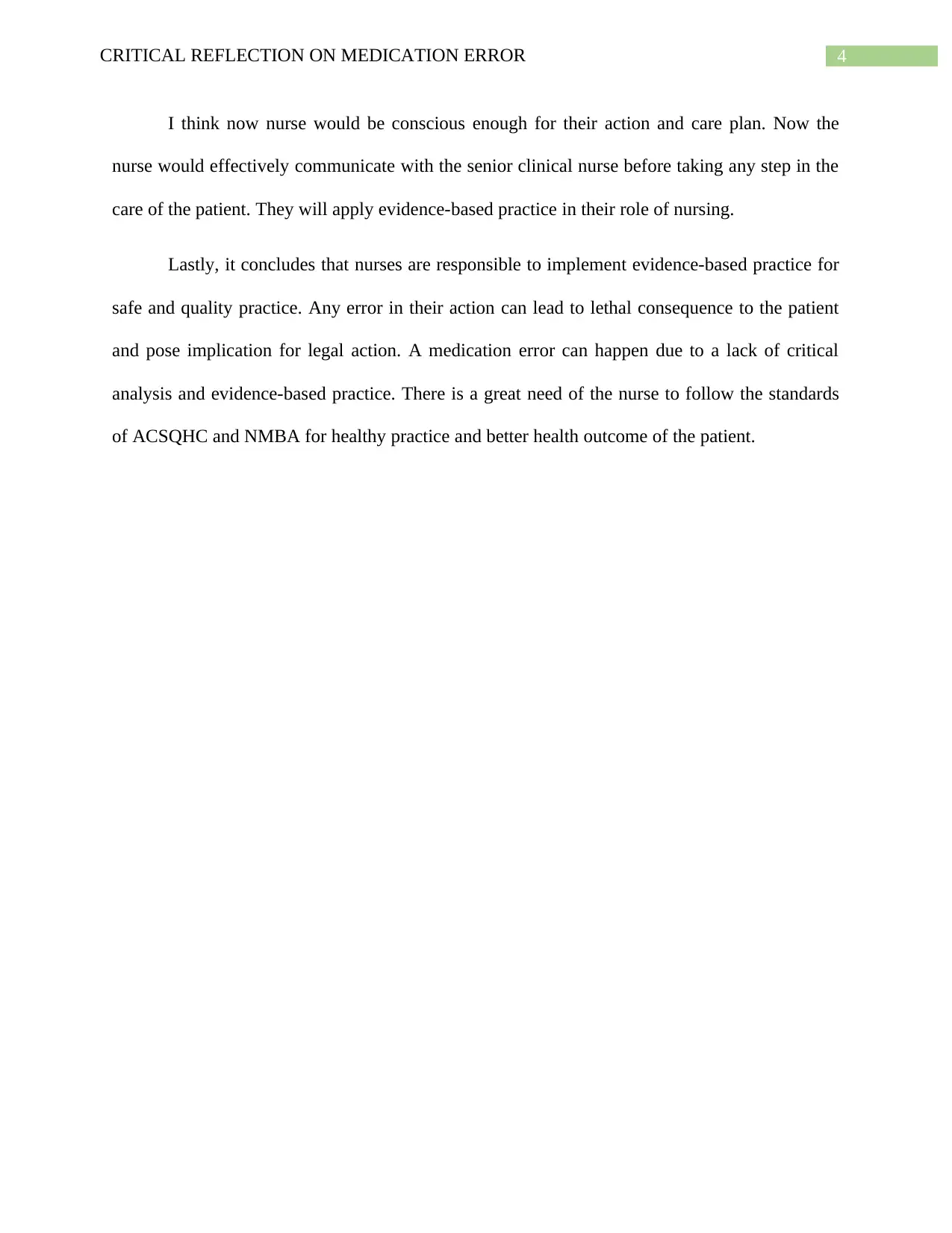
4CRITICAL REFLECTION ON MEDICATION ERROR
I think now nurse would be conscious enough for their action and care plan. Now the
nurse would effectively communicate with the senior clinical nurse before taking any step in the
care of the patient. They will apply evidence-based practice in their role of nursing.
Lastly, it concludes that nurses are responsible to implement evidence-based practice for
safe and quality practice. Any error in their action can lead to lethal consequence to the patient
and pose implication for legal action. A medication error can happen due to a lack of critical
analysis and evidence-based practice. There is a great need of the nurse to follow the standards
of ACSQHC and NMBA for healthy practice and better health outcome of the patient.
I think now nurse would be conscious enough for their action and care plan. Now the
nurse would effectively communicate with the senior clinical nurse before taking any step in the
care of the patient. They will apply evidence-based practice in their role of nursing.
Lastly, it concludes that nurses are responsible to implement evidence-based practice for
safe and quality practice. Any error in their action can lead to lethal consequence to the patient
and pose implication for legal action. A medication error can happen due to a lack of critical
analysis and evidence-based practice. There is a great need of the nurse to follow the standards
of ACSQHC and NMBA for healthy practice and better health outcome of the patient.
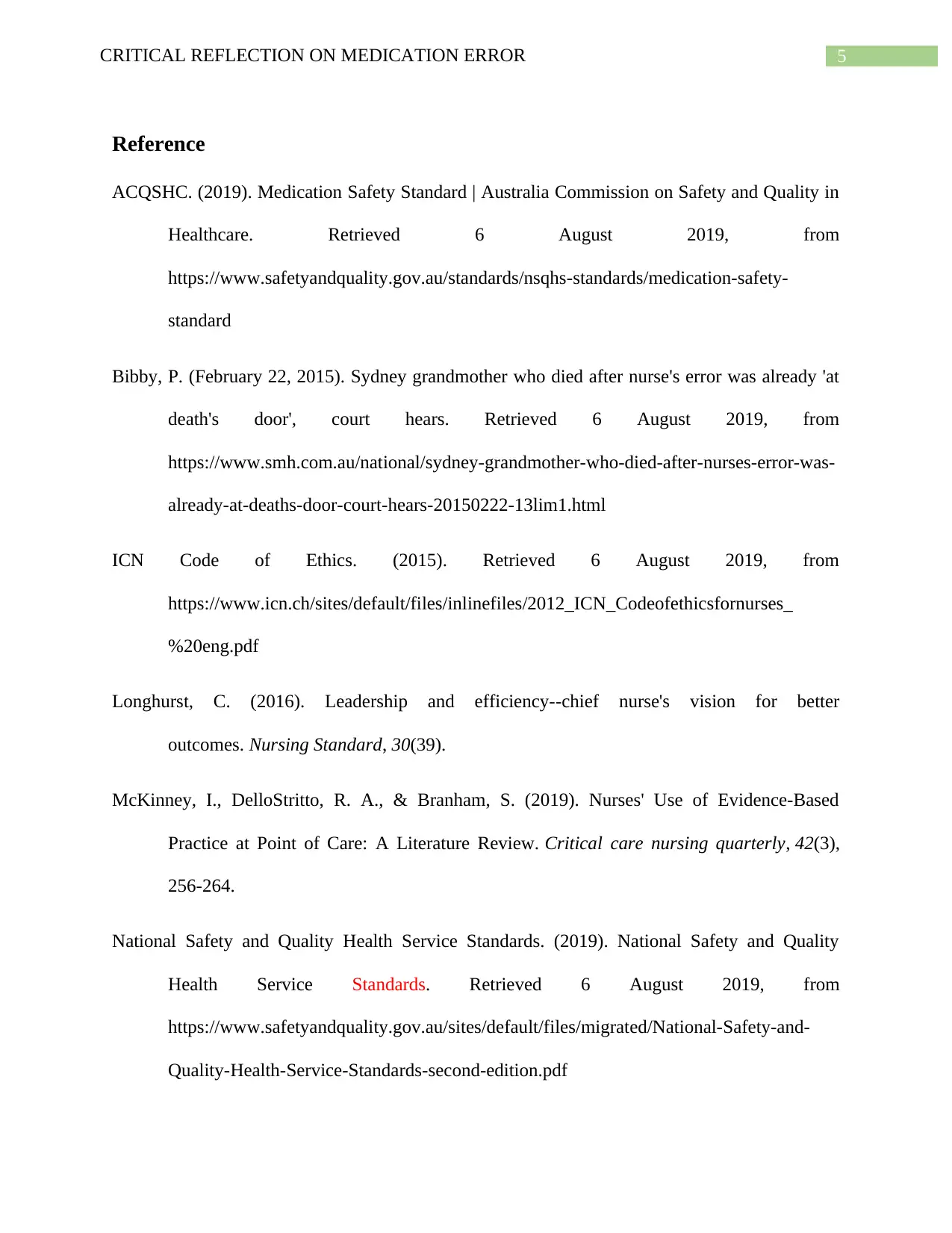
5CRITICAL REFLECTION ON MEDICATION ERROR
Reference
ACQSHC. (2019). Medication Safety Standard | Australia Commission on Safety and Quality in
Healthcare. Retrieved 6 August 2019, from
https://www.safetyandquality.gov.au/standards/nsqhs-standards/medication-safety-
standard
Bibby, P. (February 22, 2015). Sydney grandmother who died after nurse's error was already 'at
death's door', court hears. Retrieved 6 August 2019, from
https://www.smh.com.au/national/sydney-grandmother-who-died-after-nurses-error-was-
already-at-deaths-door-court-hears-20150222-13lim1.html
ICN Code of Ethics. (2015). Retrieved 6 August 2019, from
https://www.icn.ch/sites/default/files/inlinefiles/2012_ICN_Codeofethicsfornurses_
%20eng.pdf
Longhurst, C. (2016). Leadership and efficiency--chief nurse's vision for better
outcomes. Nursing Standard, 30(39).
McKinney, I., DelloStritto, R. A., & Branham, S. (2019). Nurses' Use of Evidence-Based
Practice at Point of Care: A Literature Review. Critical care nursing quarterly, 42(3),
256-264.
National Safety and Quality Health Service Standards. (2019). National Safety and Quality
Health Service Standards. Retrieved 6 August 2019, from
https://www.safetyandquality.gov.au/sites/default/files/migrated/National-Safety-and-
Quality-Health-Service-Standards-second-edition.pdf
Reference
ACQSHC. (2019). Medication Safety Standard | Australia Commission on Safety and Quality in
Healthcare. Retrieved 6 August 2019, from
https://www.safetyandquality.gov.au/standards/nsqhs-standards/medication-safety-
standard
Bibby, P. (February 22, 2015). Sydney grandmother who died after nurse's error was already 'at
death's door', court hears. Retrieved 6 August 2019, from
https://www.smh.com.au/national/sydney-grandmother-who-died-after-nurses-error-was-
already-at-deaths-door-court-hears-20150222-13lim1.html
ICN Code of Ethics. (2015). Retrieved 6 August 2019, from
https://www.icn.ch/sites/default/files/inlinefiles/2012_ICN_Codeofethicsfornurses_
%20eng.pdf
Longhurst, C. (2016). Leadership and efficiency--chief nurse's vision for better
outcomes. Nursing Standard, 30(39).
McKinney, I., DelloStritto, R. A., & Branham, S. (2019). Nurses' Use of Evidence-Based
Practice at Point of Care: A Literature Review. Critical care nursing quarterly, 42(3),
256-264.
National Safety and Quality Health Service Standards. (2019). National Safety and Quality
Health Service Standards. Retrieved 6 August 2019, from
https://www.safetyandquality.gov.au/sites/default/files/migrated/National-Safety-and-
Quality-Health-Service-Standards-second-edition.pdf
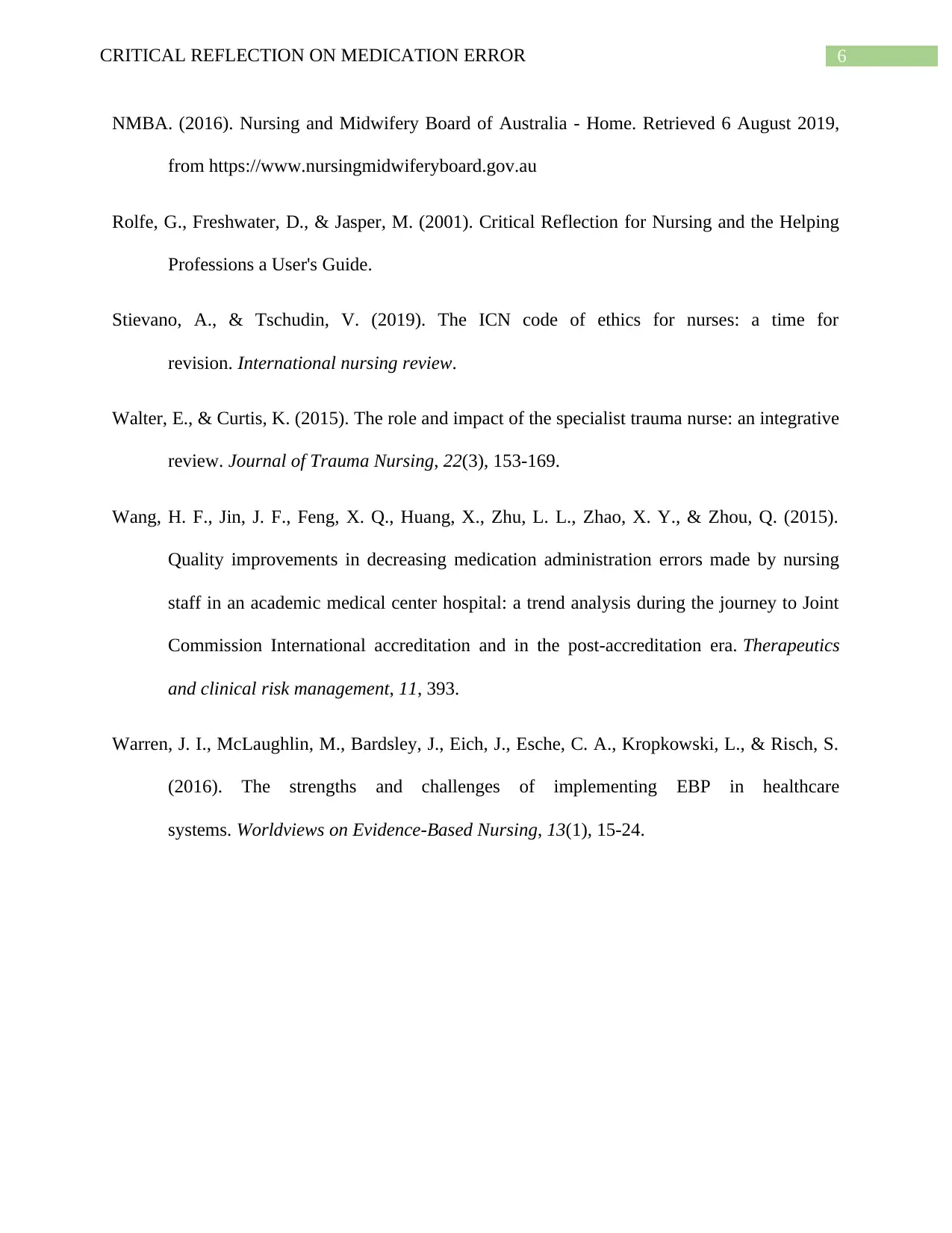
6CRITICAL REFLECTION ON MEDICATION ERROR
NMBA. (2016). Nursing and Midwifery Board of Australia - Home. Retrieved 6 August 2019,
from https://www.nursingmidwiferyboard.gov.au
Rolfe, G., Freshwater, D., & Jasper, M. (2001). Critical Reflection for Nursing and the Helping
Professions a User's Guide.
Stievano, A., & Tschudin, V. (2019). The ICN code of ethics for nurses: a time for
revision. International nursing review.
Walter, E., & Curtis, K. (2015). The role and impact of the specialist trauma nurse: an integrative
review. Journal of Trauma Nursing, 22(3), 153-169.
Wang, H. F., Jin, J. F., Feng, X. Q., Huang, X., Zhu, L. L., Zhao, X. Y., & Zhou, Q. (2015).
Quality improvements in decreasing medication administration errors made by nursing
staff in an academic medical center hospital: a trend analysis during the journey to Joint
Commission International accreditation and in the post-accreditation era. Therapeutics
and clinical risk management, 11, 393.
Warren, J. I., McLaughlin, M., Bardsley, J., Eich, J., Esche, C. A., Kropkowski, L., & Risch, S.
(2016). The strengths and challenges of implementing EBP in healthcare
systems. Worldviews on Evidence‐Based Nursing, 13(1), 15-24.
NMBA. (2016). Nursing and Midwifery Board of Australia - Home. Retrieved 6 August 2019,
from https://www.nursingmidwiferyboard.gov.au
Rolfe, G., Freshwater, D., & Jasper, M. (2001). Critical Reflection for Nursing and the Helping
Professions a User's Guide.
Stievano, A., & Tschudin, V. (2019). The ICN code of ethics for nurses: a time for
revision. International nursing review.
Walter, E., & Curtis, K. (2015). The role and impact of the specialist trauma nurse: an integrative
review. Journal of Trauma Nursing, 22(3), 153-169.
Wang, H. F., Jin, J. F., Feng, X. Q., Huang, X., Zhu, L. L., Zhao, X. Y., & Zhou, Q. (2015).
Quality improvements in decreasing medication administration errors made by nursing
staff in an academic medical center hospital: a trend analysis during the journey to Joint
Commission International accreditation and in the post-accreditation era. Therapeutics
and clinical risk management, 11, 393.
Warren, J. I., McLaughlin, M., Bardsley, J., Eich, J., Esche, C. A., Kropkowski, L., & Risch, S.
(2016). The strengths and challenges of implementing EBP in healthcare
systems. Worldviews on Evidence‐Based Nursing, 13(1), 15-24.
1 out of 7
Related Documents
Your All-in-One AI-Powered Toolkit for Academic Success.
+13062052269
info@desklib.com
Available 24*7 on WhatsApp / Email
![[object Object]](/_next/static/media/star-bottom.7253800d.svg)
Unlock your academic potential
© 2024 | Zucol Services PVT LTD | All rights reserved.





